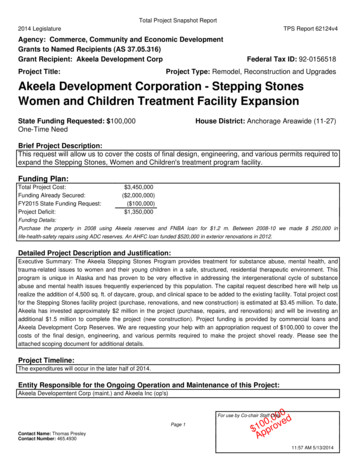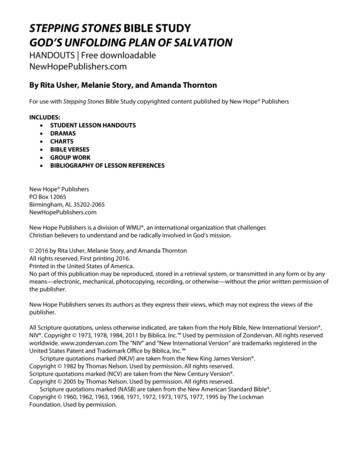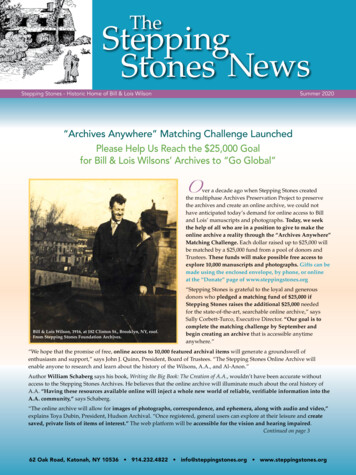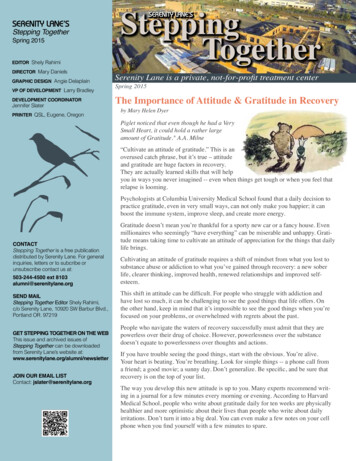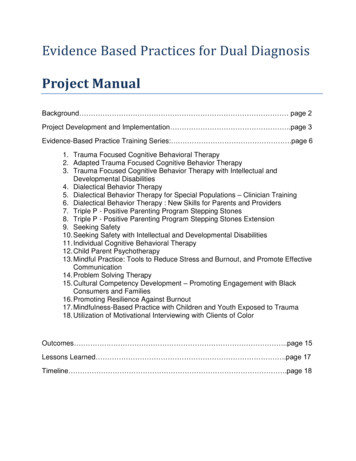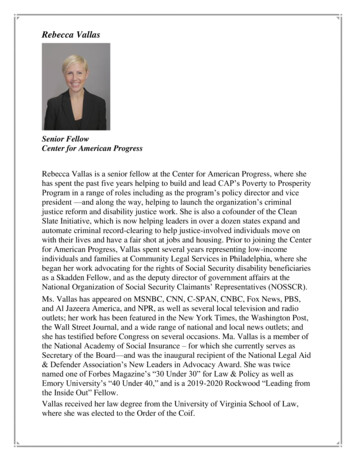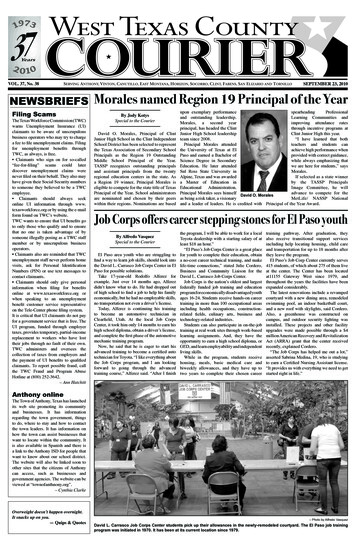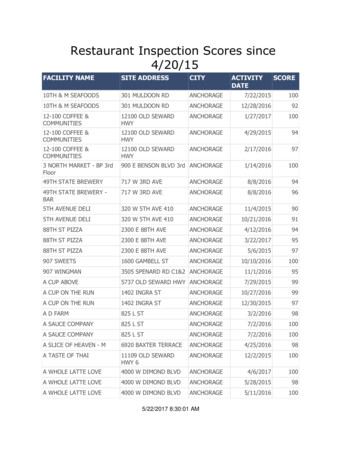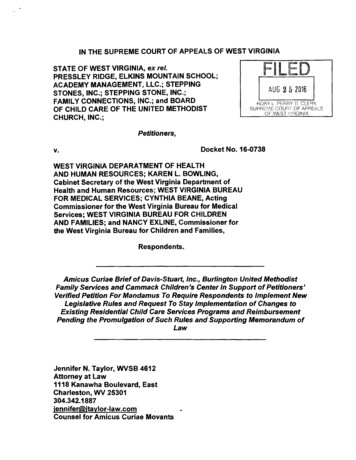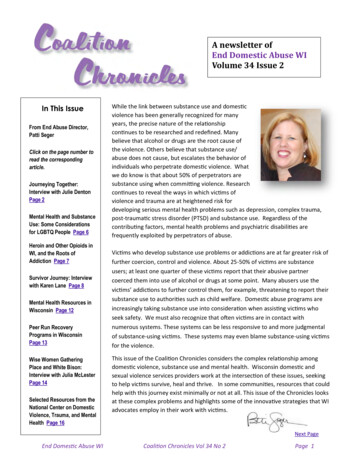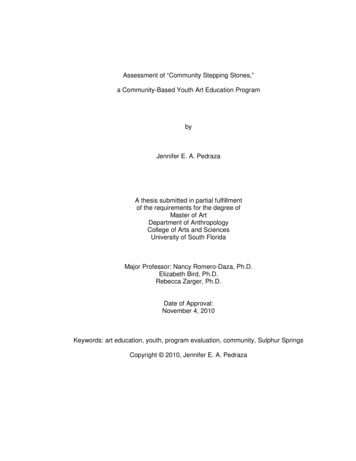
Transcription
Assessment of “Community Stepping Stones,”a Community-Based Youth Art Education ProgrambyJennifer E. A. PedrazaA thesis submitted in partial fulfillmentof the requirements for the degree ofMaster of ArtDepartment of AnthropologyCollege of Arts and SciencesUniversity of South FloridaMajor Professor: Nancy Romero-Daza, Ph.D.Elizabeth Bird, Ph.D.Rebecca Zarger, Ph.D.Date of Approval:November 4, 2010Keywords: art education, youth, program evaluation, community, Sulphur SpringsCopyright 2010, Jennifer E. A. Pedraza
DedicationI would like to dedicate this manuscript to my family. My husband, Matthew, whoremained supportive to the very end. To my two children, Lilith and Xavier who loved meand distracted me when I most needed it. And to my mom, Lynn, and sister, Sarah, wholistened to all my frustrations.
AcknowledgmentsThank you to all of the staff, volunteers, and students at Community Stepping Stones forbeing so open and supportive of me and my research.Thank you to my thesis advisor, Dr. Nancy Romero-Daza, for guiding and supporting methrough this process and for my committee members, Dr. Elizabeth Bird and Dr.Rebecca Zarger, who readily shared their wisdom and time.And thank you to Sue Rhinehart and the rest of the Department of Anthropologyadministrative staff who kept me on my toes and helped me stay on top of deadlines andcomplete all the necessary paperwork.Without you, this manuscript would not be possible. Thank you.
Table of ContentsList of FiguresvAbstractviChapter One: Introduction1Internship Location1Sulphur Springs1History of Sulphur Springs1Present day Sulphur Springs3Sulphur Springs resources5Community Stepping Stones6Community Stepping Stones background6Goals and objectives7Community Stepping Stones art classes8Community Stepping Stones outreach programs9Community Stepping Stones workforce10Community Stepping Stones in action11Community art12Community stewardship13My RoleChapter Two: Relevant Literature1319i
Childhood in Anthropology19The early years19Six Cultures Studies22New Directions in “child centered” research22Children and research25Gatekeepers25Cognitive development and consent25Representation, translation, and power27Youth ProgramsArt Education Programs2728Art education program framework29Art education program staff29Training30Student Participation32Art education program evaluation34Process evaluation36Outcome evaluation37What does this mean?Chapter Three: MethodologyInternship Location434444Art education class45National Endowment for the Arts mural project46Other observations47Benefits of participation48Interviews48Document Review51ii
Chapter Four: Findings & DiscussionLocation5252The Art House and the Business52The Business56Mann Wagnon Memorial Park57Staff, student, and volunteer feelings about location60Funding61AmeriCorps62National Endowment for the Arts mural grants65Non-grant funding sources69Teen’s Social Entrepreneurship Programs69Fundraising70Staff and Volunteers72Executive Director72AmeriCorps impact on staff73Volunteers76USF community art class volunteers79Community Engagement80Rowlett Park murals81Sulphur Springs Message Center83Community parades84Community Collaborations and Partnerships84United Drops Make Waves85Seeds in the Spring85Other collaborative efforts87Students89Programming92Student involvement95iii
Organic growth96Goals and Objectives97Evaluation97Current measures98Future measures100Chapter Five: Conclusion and SF community art class106Community Engagement107Community Collaboration and 110Looking to the Future111Chapter Six: Challenges & Limitations113Bibliography117Appendices125Appendix A: Community Stepping Stones Letter of Support126Appendix B: Interview Protocols127Appendix C: Letters to Study Participants134iv
List of FiguresFIGURE 1: Community Stepping Stones Art House53FIGURE 2: Community Stepping Stones neighborhood55FIGURE 3: Community Stepping Stones “The Business”56FIGURE 4: Mann Wagnon Memorial Park57FIGURE 5: National Endowment for the Arts Mural project68FIGURE 6: Rain Barrels71FIGURE 7: Rowlett Park Mural: “You Me Community”82FIGURE 8: Rowlett Park Murals: “Exactly”83FIGURE 9: “Sulphur Springs Message Center”84FIGURE 10: Community Stepping Stones youth participants86v
AbstractCommunity Stepping Stones is an art education program whose objective is to“provide education, mentor children and adolescents, enhance the communityeconomics, and enrich the quality of life in the community” (Community StepppingStones [CSS], 2009a). Community art education programs, particularly for youth, havebecome increasingly popular as a way to address and prevent delinquent behavior.However, art education programs have proven challenging to evaluate and sustain.The goal of my thesis was to explore how Community Stepping Stonesimplemented and evaluated a community-based youth arts education programcompared to other, similar programs and how the organization could make the programmore effective and more sustainable long-term. As part of an internship with CommunityStepping Stones, I conducted participant observation, document review, and interviewswith individuals affiliated with Community Stepping Stones and other art educationprograms in the community. Data was collected between February 2009 and September2010.Community Stepping Stones has grown significantly during my involvement withthe organization, expanding funding, programming, and staff. Current efforts to reinforceevaluation measures and secure additional funding sources will help make the programmore sustainable in the future. Additional efforts towards collaboration with othercommunity and government organizations, increased community involvement, and betterprogram organization will also be beneficial towards sustainability efforts.vi
At this time, published evaluations of community-based youth art educationprograms and organizational impact on youth and community are limited. Although not acomprehensive assessment, I hope my research can help bolster the literature in thisarea.vii
Chapter 1: IntroductionThis thesis discusses an assessment of Community Stepping Stones, acommunity-based youth art education program located in Sulphur Springs, Florida. Theassessment was conducted during the summer of 2010 with the goal of exploring howCommunity Stepping Stones implemented and evaluated a community-based youth artseducation program compared to other, similar programs. Based on ethnographicmethods, including participant observation, interviews, and a document review, wereused to inform the assessment. Data collected from the assessment as well as aliterature review were used to explore how the organization could make the programmore effective and more sustainable.Internship LocationSulphur Springs. Sulphur Springs is a neighborhood located in Tampa, Florida.Referred to as the Sulphur Springs Action League in most government documentation,the neighborhood covers approximately one square mile and is defined as being locatedbetween Busch Blvd. to the north, the Hillsborough River to the south, the railroad tracksto the east, and Nebraska Avenue to the west (Hillsborough Community Atlas [HCA],2009; Planning Commission 2004).History of Sulphur Springs. The name ‘Sulphur Springs’ is derived from theunderground spring located off Nebraska Avenue. Originally developed in the early1
1900s, Sulphur Springs began as a thriving tourist area. Dr. John Mills originally begandevelopment of the area; building bath houses, a restaurant, a dock and pool, a fishpond, and walking trails near the underground spring. His intention was for people toenjoy the “healthfulness of nature” (Planning Commission 2004, p.2). By 1920, Mills hadsold a large portion of his land to Josiah Richardson, a real estate developer (PlanningCommission 2004; Armstrong & Jackson 2007). Richardson was largely responsible fordeveloping Sulphur Springs into the well-known tourist destination of the 1920s. Addingto the tourist attractions Mills had built, Richardson built a gazebo, slide, alligator farm,and the well known Sulphur Springs Water Tower and Sulphur Springs pool. Theseattractions were followed by the building of the Sulphur Springs Hotel and Arcade, whichwas completed in 1927. A predecessor to today’s shopping malls, the hotel and arcadesoon became the heart of Sulphur Springs, even being recognized by Ripley’s Believe itor Not as “a city under one roof” (Planning Commission 2004, Heritage Researcher2007).Although mostly known as a tourist attraction, the Sulphur Springs area also sawsignificant residential growth in the 1920s and 30s (Planning Commission 2004). Inaddition to the mostly middle-class, white development in the area, a small AfricanAmerican farming community known as Spring Hill was also thriving along thenorthwestern section of present day Sulphur Springs (Planning Commission 2004,Heritage Researcher 2007). Despite their contribution to the area, African Americanresidents of Spring Hill were largely excluded from Sulphur Springs attractions due toracial segregation (Jackson 2009, Sulphur Springs Museum 2009). Segregation lawsprohibited African American residents from entering the Sulphur Springs arcade or pool.This segregation is manifested today in the lack of historical documentation of AfricanAmerican residents in the Sulphur Springs area (Jackson 2009, Sulphur Springs2
Museum 2009). Although Spring Hill was originally considered a separate community, itis now generally recognized as part of Sulphur Springs.Sulphur Springs and Spring Hill continued to thrive until the Great Depressioncrippled the local economy (Planning Commission 2004). A serious flood hit the SulphurSprings area towards the end of the Great Depression, further hindering the area’seconomic recovery. As the economy continued to decline in the Sulphur Springs area,the North Tampa Chamber of Commerce and the City of Tampa took control of the hoteland arcade in an attempt to revitalize the area (Planning Commission 2004). By the1970s, regardless of attempts by the city to combat deterioration, Sulphur Springscontinued to see commercial and residential decline. The hotel and arcade wereultimately demolished in 1976 to make way for parking for the dog tracks (PlanningCommission 2004) and the natural spring was closed in 1986 due to sink holes andstorm runoff (Sulphur Springs Museum 2010). Sulphur Springs has continued todeteriorate economically, creating social burdens on the community.Present day Sulphur Springs. As of 2000, Sulphur Springs had a population of6,303, 41% of whom were under the age of 18 (United States Census 2000). Once athriving tourist destination, Sulphur Springs now struggles with extreme poverty, highcrime rates, and a shortage of public resources.Sulphur Springs has one of the highest poverty rates in the county. With anestimated per capita income of only 10,592, Sulphur Springs lags behind Tampa( 22,010), Hillsborough County ( 21,818), and the State of Florida ( 21,557) and puts43% of Sulphur Springs residents below poverty level (HCA 2009; United States Census2000). Even more alarming is that 56% of residents below poverty level are under theage of 18 (HCA 2009). Another indicator of the high poverty level among children inSulphur Springs is the high percentage of students at the Sulphur Springs Elementary3
school who receive free or reduced lunch; a full 96%. Although not a direct indicator ofpoverty, single-parent families are generally associated with poor economic condition(Annie E. Casey Foundation [AEC] 2010). With 31% of Sulphur Springs residents livingin a single parent family, fully three times as many as the City of Tampa, HillsboroughCounty, or the State of Florida, it is evident that this is another risk factor for SulphurSprings residents, particularly its youth (HCA 2009).Housing arrangements in Sulphur Springs also indicate a community in need.The Sulphur Springs community is highly transient; nearly 57% of residents rent theirhome and 62% have lived in Sulphur Springs for less than five years (HCA 2009).Sulphur Springs also suffers from a high foreclosure rate. At 13.6% in 2009, foreclosurerates in Sulphur Springs were significantly higher than the City of Tampa (6.35%). Thesestatistics suggests that Sulphur Springs does not offer a stable living environment forresidents and is economically challenged.Criminal activity in Sulphur Springs is also a concern. Domestic violence is anissue in the community, particularly for children. Sulphur Springs ranks eighth amongapproximately 100 Hillsborough county communities for reported cases of domesticviolence in general and the community ranks sixth for domestic violence reportsinvolving children (HCA 2009). There is also a high rate of involvement in the juvenilejustice system in Sulphur Springs compared to the rest of Tampa (HCA 2009).Sulphur Springs is further challenged by a lack of local resources. In June 2004,the Hillsborough County City-County Planning Commission published a report entitled“The Neighborhood Strategy: Our Pathway to a Better Tomorrow” (Planning Commission2004). Born out of two neighborhood meetings held at the George Bartholomew NorthTampa Community Center, which is located in Sulphur Springs; the report identifiesresources, needs, and future goals of Sulphur Springs residents (Planning Commission4
2004). One of the main concerns identified at the meetings was a lack of resourcesavailable to the community, including safe places for children to play and availablecommunity services.Sulphur Springs resources. Sulphur Springs covers a relatively small area ofonly one square mile and hosts one school, Sulphur Springs Elementary School, andone community center, the George Bartholomew North Tampa Community Center.Compared to the rest of Tampa, Sulphur Springs has a significant amount of recreationalarea proportionate to the community. In addition to a playground, the Community Centeroffers after school programming, basketball courts, a computer lab, weight room, andother indoor recreational activities (Tampa Department of Parks & Recreation [TDP&R]2010). Although the Community Center is a prominent feature in Sulphur Springs, thecenter is no longer accessible to most Sulphur Springs residents. Previously open to thegeneral public free of charge, fees were enacted in 2009; residents must now pay a 15membership fee as well as additional fees for most activities (Steele & Wilkens 2010,TDP&R 2010). The cost of the after school program available through the communitycenter was also dramatically increased during the same time period (Steele & Wilkens2010). The institution of membership and activity fees and the increase in feesassociated with the after school program is financially out of reach for many SulphurSprings residents and has resulted in a significant drop in attendance at the communitycenter (Steele & Wilkens 2010).Community concerns over safe places for children to play was identified as anissue even prior to the rate increases and subsequent drop in attendance at thecommunity center (Planning Commission 2004). However, according to the PlanningCommission report, one of the most important resources identified and a major area thecommunity wished to further develop was the community’s youth. An overwhelming5
number of Sulphur Springs residents agreed that “if we can provide programs for kids,we can get them off the streets” (Planning Commission 2004, p7).It is evident, though, that youth in Sulphur Springs are at a serious disadvantage.Youth are exposed to high poverty rates, high crime rates, family and residentialinstability, and a lack of community resources. Studies show that such risk factors putchildren at greater risk for behavioral, mental, and physical health issues (AEC 2009,Larson 2008), lower academic achievement; (AEC 2009, Snow, Burns, & Griffin 1998)and are more likely to skip a meal or not have enough to eat on a daily basis (NationalCenter for Health Statistics [NCHS] 2010). Multiple risk factors are also linked to anincreased likelihood of a child being involved in illegal activities such as alcohol and druguse, truancy, gang involvement, and violent crimes (Health of Children 2010). ThePlanning Commission Report “asserts that for youth to learn to be productive,connected, and able to navigate [these risks], they must experience a set of supportsand opportunities that are the critical building blocks of development across all of thesettings in which they spend their time” (Planning Commission 2004, p.11).Community Stepping Stones. Community Stepping Stones is an art educationprogram located in Sulphur Springs, Florida. Founded in 2004 by an adjunct artprofessor and several of his students from the University of South Florida, CommunityStepping Stones claims to be “dedicated to providing education, mentoring children andadolescents, enhancing the community economics, and enriching the quality of life in thecommunity” (CSS 2009a).Community Stepping Stones background. The Community Stepping Stonesfounder presented his idea of an art education program, then called the GoodCommunity Alliance, to the Hillsborough County Arts Council in 2004. With theassistance of the Council, he was able to obtain 501(c)3 status for the Good Community6
Alliance shortly thereafter. The Good Community Alliance has since served as thebusiness name for Community Stepping Stones. The Hillsborough County Arts Councilhas continued its support of Community Stepping Stones through annual financialassistance for the organization since 2004. Match funds have also been received fromthe Children’s Board of Hillsborough County on an annual basis since the forming of theGood Community Alliance/Community Stepping Stones. Around the same time the GoodCommunity Alliance/Community Stepping Stones obtained 501(c)3 status, the Universityof South Florida, School of Art and Art History was awarded an endowment forcommunity art and youth education. Given the organization’s similar goals, theendowment was awarded to Community Stepping Stones in 2004. Additional grantshave been awarded over the years, although most have been smaller, one-time grants.Once funding was secure, Community Stepping Stones began the process of programdevelopment.The founder of Community Stepping Stones has resided in and has a history ofcommunity involvement in Sulphur Springs for over 20 years. Through his involvement,Community Stepping Stones was able to obtain support and guidance from the SulphurSprings Neighborhood Association, Sulphur Springs Alliance, USF College of Visual andPerforming Arts and the USF School of Art and Art History in developing a programformat that was receptive to Sulphur Springs community needs and an effective arteducation program.Goals and objectives. As part of program development, specific goals andobjectives were identified. Community Stepping Stones’ stated goals are: “to keep the youth of Sulphur Springs in school,to give our youth the tools to continue their education after highschool,7
to fill our youth with hope and visions of their future,to be an agent for social change,to be a catalyst for community cohesiveness,to make a real impact on the lives of children,to develop art and educational programs that address social andenvironmental issues,to utilize art as a tool in teaching children about caring for theircommunity, andto partner with local art and education organizations” (CSS2009b).Community Stepping Stone’s objectives are: “to develop creative and critical thinking skills resulting inincreased grades and social awareness and a desire to continueeducation after high school,to develop our youth’s self esteem through their work beingdisplayed,to engage in meaningful community service to strengthen SulphurSprings, andto partner with the University of South Florida and HillsboroughCommunity College” (CSS 2009b).These goals and objectives are explored as part of my assessment of CommunityStepping Stones. In addition to an observational assessment, interview questionsexplored staff and volunteer perceptions of organizational goals and objectives.Community Stepping Stones art classes. One of the main avenuesCommunity Stepping Stones uses to accomplish these goals and objectives is throughregular art education programs for area youth. Classes are offered to youth inelementary school through high school in an after school setting as well as throughsummer programs at the Mann Wagnon Memorial Park in Sulphur Springs. Classes aregenerally held every week day and cover a variety of art forms, such as photography,painting, ceramics, silk screening (t-shirt making), poetry, song writing, and many othercreative mediums. Most classes independent of each other, but some lessons carryover on a daily or weekly basis. Community Stepping Stones frequently conducts special8
events on the weekend as well, such as taking students to museums, attending localcultural events, or hosting activities at Mann-Wagnon Memorial Park. Over 50 studentsattend classes on a weekly basis with another 50 youth served through outreachprograms with other community organizations in Sulphur Springs and the larger Tampaarea.Community Stepping Stones outreach programs. Community SteppingStones has collaborated with the City of Tampa Parks and Recreation Department andthe Tampa Housing Authority to provide art classes at local after-school programsoffered by the government agencies. Classes are currently offered at the GeorgeBartholomew North Tampa Community Center in Sulphur Springs, which is run by theCity of Tampa Parks and Recreation Department. Other than a membership fee for theParks and Recreation Department, the after-school program is free to Tampa residents(Steele & Wilkens 2010). The program offers after school care for children ages five totwelve years of age and provides homework assistance, sports and fitness activities, andart programming (Steele & Wilkens 2010, TDP&R 2010).Youth art classes are also offered at the Tampa Housing Authority’sNeighborhood Network Center, River Oaks site (CSS 2009b). The Tampa HousingAuthority’s Neighborhood Network Centers offer personal development programs foradults and after school care for youth. After school programming focuses on academicsupport and job preparation, including computer literacy, life skills, job search, andABE/GED classes (Tampa Housing Authority 2010). Art classes are provided byCommunity Stepping Stones staff on a weekly basis and cover a variety of art mediumsdepending on the individual programs’ resources. Approximately 50 youth are servedthrough these programs on a weekly basis. Staff have indicated that CommunityStepping Stones does not currently have a financial agreement with either of these9
programs, although they are trying to negotiate something for the future. At this time it isunclear whether the government organizations will be able to pay Community SteppingStones for its services.In addition to ongoing negotiations with the City of Tampa Parks and RecreationDepartment and the Tampa Housing Authority, Community Stepping Stones hascontinued to pursue collaborative agreements with other government and communityorganizations. At this time, Community Stepping Stones is working with the Departmentof Juvenile Justice to accept mild and moderate juvenile offenders from the SulphurSprings area as part of the youth’s probation (CSS 2009b). The youth’s participation inCommunity Stepping Stones programming will be a condition of the youth’s probation.As part of this agreement, Community Stepping Stones has even offered space at theMann-Wagnon Memorial Park for probation officers to meet juvenile offendersparticipating in Community Stepping Stones (CSS 2009b). Other youth art educationprograms have successfully made similar agreements with the Department of JuvenileJustice (Prodigy 2010).Community Stepping Stones workforce. Community Stepping Stones recentlyincreased the number of staff members from four full-time staff and two-part time artinstructors to six full-time staff and four part-time staff and art instructors. Full-time staffinclude an Executive Director, AmeriCorps Program Director, a Community-VolunteerCoordinator, an After School Art Program Coordinator, a Community AllianceCoordinator, and a Programming Coordinator. Part-time staff include an EventCoordinator and three Youth Art Instructors. With the exception of the Executive Directorand the AmeriCorps Program Director, staff are paid through an AmeriCorps grantinitially awarded in August of 2009. The Executive Director and the AmeriCorps ProgramDirector are match-based positions, meaning their salary must come from sources other10
than the AmeriCorps grant. Independent artists are also hired on occasion to assist withspecial projects or to teach specific art mediums. However, with over 8,000 volunteerhours logged in 2007 and again in 2008, Community Stepping Stones considers itself avolunteer-based organization (CSS 2009b).The majority of Community Stepping Stones volunteers are students from localcolleges and universities, including the University of South Florida (USF), HillsboroughCommunity College (HCC), and the University of Tampa (UT). The University of SouthFlorida Center for Leadership and Civic Engagement has partnered with CommunityStepping Stones on several occasions to provide volunteers for special projects, such asclean-up and fundraising events. In addition to the Center for Leadership and CivicEngagement, an average of 10 volunteers attend each semester as part of an art classexploring community art offered by the College of the Arts at the University of SouthFlorida. Volunteers from this class are usually art students who attend regularly duringtheir semester long class and assist Community Stepping Stones art instructors in thedaily art classes. Community Stepping Stones leaders believe “the consistent contactwith the area colleges and their students not only exposes our children and youth to theidea of higher education, it normalizes it” (CSS 2009a). Graduated Community SteppingStones students often return to work as art instructors, reinforcing the importance ofsocial responsibility.Community Stepping Stones in action. In addition to art classes and theconsistent presence of college and university students, Community Stepping Stonesstrives to help better its student participants and the Sulphur Springs Community.Students receive support and encouragement from Community Stepping Stones staffand volunteers in a variety of ways. Participating students are expected to maintain goodgrades, stay out of trouble, participate in community service, regularly attend art classes,11
apply learned skills to a specific job at Community Stepping Stones, and work on the job(CSS 2009a). Students are taught to maintain good grades in order to get into collegeand obtain scholarships. Community Stepping Stones has even partnered withHillsborough Community College to provide academic and financial assistance toCommunity Stepping Stones students who enroll in the college (CSS 2009a). Efforts arealso made to acknowledge that the work and efforts of the students are important.Funding is obtained to pay students for attending art classes and working on theirCommunity Stepping Stones “jobs.” Student art work is also displayed annually at theUniversity of South Florida Oliver Art Gallery and the Hillsborough Community CollegeArt Gallery (CSS 2009a).Community art. Although Community Stepping Stones’ main focus is daily artclasses, they have also completed several more permanent community art projectsthroughout the community. Community art installments are meant to engage andbeautify the community. Community art installments include two large-scale murals atthe Rowlett Park Recreation Center, a sculptural message center that replicates theSulphur Springs Tower located at River Cover Park, and an art business run byparticipating adolescents. More recently, area youth were engaged in two projects duringthe summer of 2010. One was an art project completed in response to the Gulf oil spill ofMay 2010. Completed in several steps, the project depicted the student’s feelings aboutthe oil spill and the impact it might have on their community. In addition to beingdisplayed in several locations throughout Tampa, the resulting art piece wasphotographed and sent to local and national politicians along with a letter. Activities suchas this are designed to empower students by engaging them in larger social and politicalissues and by showing students that their involvement can have an impact on local, city,state, and national outcomes.12
A mural project was also completed over the summer. After extensive interviewswith area residents, youth completed a mural on the north side of the historic SulphurSprings Theater. The mural depicts images of individuals, including a man teaching aboy to ride a bike, and words representing community; student’s interpretation ofresidents’ feelings about Sulphur Springs’ past and present. Students expressed asense of ownership and community stewardship because they conducted the interviews,developed the mural design, and painted the mural themselves. In addition to engagingthe youth in a positive activity, the mural project helped to empower the students whilebeautifying the local community; two important aspects of Community Stepping Stones.Community stewardship. Community stewardship is another strong focus ofCommunity Stepping Stones. In addition to beautification efforts such as the muralprojects, past endeavors have also focused on cleaning up the local environment. Effortshave included clean-up events at the Hillsborough River, local parks, and several emptylots in Sulphur Springs. Community Stepping Stones’ aim is to create positive spaces forSulphur Springs resident
Stepping Stones, I conducted participant observation, document review, and interviews with individuals affiliated with Community Stepping Stones and other art education programs in the community. Data was collected between February 2009 and September 2010.Community Stepping Stones has grown significantly during my involvement with
